I can’t remember having ever been disappointed by any of the exhibitions on show at Fotomuseum in Antwerp. The current shows are particularly worth the trip to the city (one of my favourite places in the world and it’s a mere 30 minute ride from ugly Brussels.) The main exhibition is dedicated to photographers who capture the past, another one is about young Belgian photographers, a third show explores subjectivity through history and on the top floor is a fascinating installation by Zoe Beloff. The work took as its point of departure America’s longest running comic strip to explore the influence of cinema on the movement of the body and the mind. I might come back to these exhibitions in the coming days.
Beloff’s exhibition contains a number of historical documents. Some of them show chronocyclegraphs of sportsmen and factory workers. I had never heard of the chronocyclegraph before.
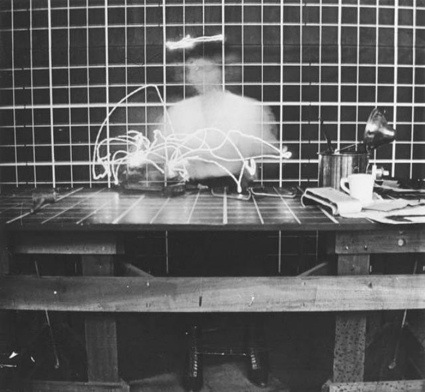 Motion Efficiency Study, c. 1914. National Museum of American History, Behring Center, Division of Work and Industry Collection
Motion Efficiency Study, c. 1914. National Museum of American History, Behring Center, Division of Work and Industry Collection
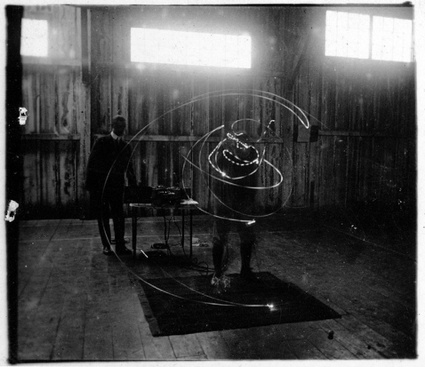 From image verso: “Chronocyclegraph of Roger [Howey?] champion golfer.” circa 1915. Collection: Frank B. Gilbreth Motion Study Photographs (1913-1917). Repository: The Kheel Center for Labor-Management Documentation and Archives
From image verso: “Chronocyclegraph of Roger [Howey?] champion golfer.” circa 1915. Collection: Frank B. Gilbreth Motion Study Photographs (1913-1917). Repository: The Kheel Center for Labor-Management Documentation and Archives
The technique was developed by Frank Gilbreth and his wife, Lillian in the early 20th century to improve work methods. The couple employed time-lapse photography to reduce a complete work cycle to the shortest and most efficient sequence of gestures.
To look for this optimal “relationship of human effort to the volume of work that the effort accomplishes”, they attached a camera to a timing device and photographed workers performing various tasks. The motion paths were traced by small lamps fastened to the worker’s hands or fingers.
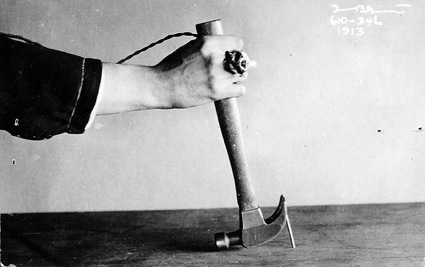 Method of attaching light to hand for cyclograph pictures. Light ring on hand holding hammer while pulling a nail. Date: 1913. Collection: Frank B. Gilbreth Motion Study Photographs (1913-1917). Repository: The Kheel Center for Labor-Management Documentation and Archives
Method of attaching light to hand for cyclograph pictures. Light ring on hand holding hammer while pulling a nail. Date: 1913. Collection: Frank B. Gilbreth Motion Study Photographs (1913-1917). Repository: The Kheel Center for Labor-Management Documentation and Archives
They called the essential elements of their subjects’ movements therbligs.
The Gilbreths later built wire sculptures based on the trail of light created by the movement of the worker’s hand.
The objective of the research was to minimize arm movement and hence speed and ease manual work. Gilbreth’s findings were used in assembly lines but they also found their way into other contexts: Gilbreth was the first to propose that a nurse would assist the surgeon, by handing them surgical instruments as called for. He also devised the standard techniques used around the world to teach army recruits how to rapidly disassemble and reassemble their weapons even when blindfolded.
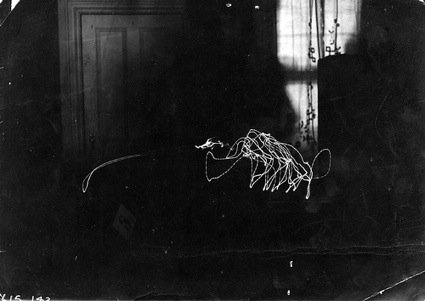 From image verso: “Chronocyclograph of surgeon sewing.” circa 1915. Collection: Frank B. Gilbreth Motion Study Photographs (1913-1917). Repository: The Kheel Center for Labor-Management Documentation and Archives
From image verso: “Chronocyclograph of surgeon sewing.” circa 1915. Collection: Frank B. Gilbreth Motion Study Photographs (1913-1917). Repository: The Kheel Center for Labor-Management Documentation and Archives
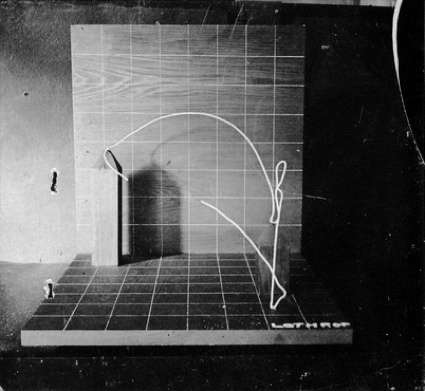 From image verso: ‘Wire model of foreman on drill press. This shows “positioning” in the midst of “transporting.”‘ Circa 1915. Collection: Frank B. Gilbreth Motion Study Photographs (1913-1917). Repository: The Kheel Center for Labor-Management Documentation and Archives
From image verso: ‘Wire model of foreman on drill press. This shows “positioning” in the midst of “transporting.”‘ Circa 1915. Collection: Frank B. Gilbreth Motion Study Photographs (1913-1917). Repository: The Kheel Center for Labor-Management Documentation and Archives
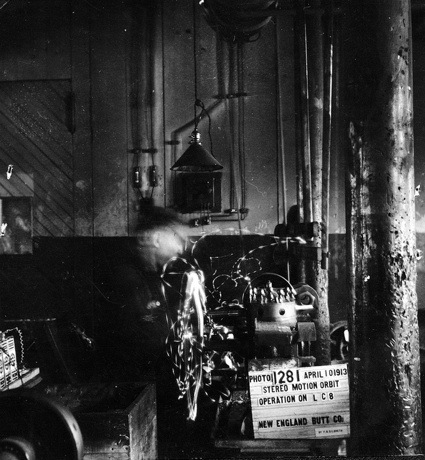 From image verso: “Same study as photo #1291.” Chronocyclograph on a turret lathe. In image “Photo 1281, April 10, 1913. Stereo Motion Orbit Operation On L C8. New England Butt Co.” Date: 1913. Collection: Frank B. Gilbreth Motion Study Photographs (1913-1917). Repository: The Kheel Center for Labor-Management Documentation and Archives
From image verso: “Same study as photo #1291.” Chronocyclograph on a turret lathe. In image “Photo 1281, April 10, 1913. Stereo Motion Orbit Operation On L C8. New England Butt Co.” Date: 1913. Collection: Frank B. Gilbreth Motion Study Photographs (1913-1917). Repository: The Kheel Center for Labor-Management Documentation and Archives
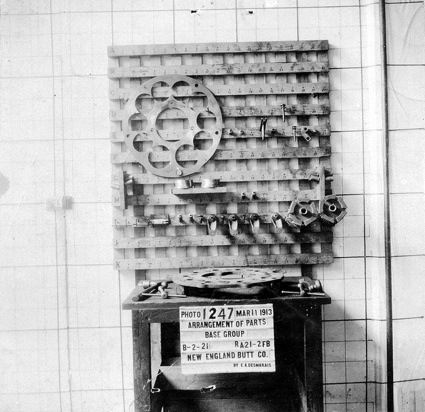 From image verso: “Assembly [packet?] of arranging in an ‘obvious sequence’ the parts of a shoe string machine. This study resulted in enabling the worker to do over 3 times as much – (see paper by John G. Aldrich, Amer Soc. Mech Engineers Transactions 1. Date: 1913. Collection: Frank B. Gilbreth Motion Study Photographs (1913-1917). Repository: The Kheel Center for Labor-Management Documentation and Archives
From image verso: “Assembly [packet?] of arranging in an ‘obvious sequence’ the parts of a shoe string machine. This study resulted in enabling the worker to do over 3 times as much – (see paper by John G. Aldrich, Amer Soc. Mech Engineers Transactions 1. Date: 1913. Collection: Frank B. Gilbreth Motion Study Photographs (1913-1917). Repository: The Kheel Center for Labor-Management Documentation and Archives
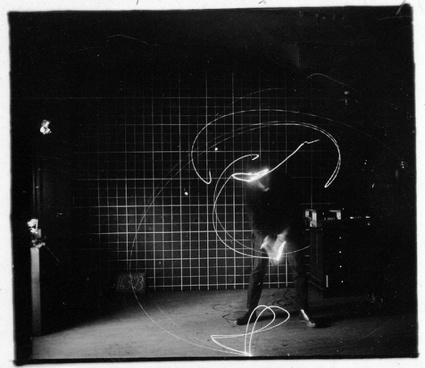 Chronocyclograph of golf champion- Francis [?] , circa 1915. Collection: Frank B. Gilbreth Motion Study Photographs (1913-1917). Repository: The Kheel Center for Labor-Management Documentation and Archives
Chronocyclograph of golf champion- Francis [?] , circa 1915. Collection: Frank B. Gilbreth Motion Study Photographs (1913-1917). Repository: The Kheel Center for Labor-Management Documentation and Archives
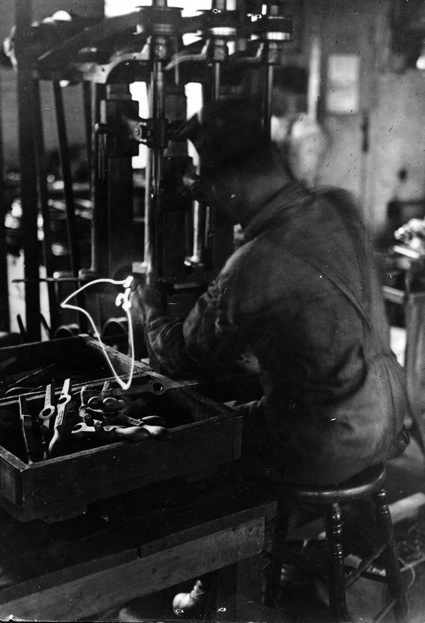 From image verso: “Left hand of drill press operator ‘Positioning after transportation’ (this study resulted in cutting the time in halves).” Machinist with light showing hand movements, circa 1915. Collection: Frank B. Gilbreth Motion Study Photographs (1913-1917). Repository: The Kheel Center for Labor-Management Documentation and Archives
From image verso: “Left hand of drill press operator ‘Positioning after transportation’ (this study resulted in cutting the time in halves).” Machinist with light showing hand movements, circa 1915. Collection: Frank B. Gilbreth Motion Study Photographs (1913-1917). Repository: The Kheel Center for Labor-Management Documentation and Archives
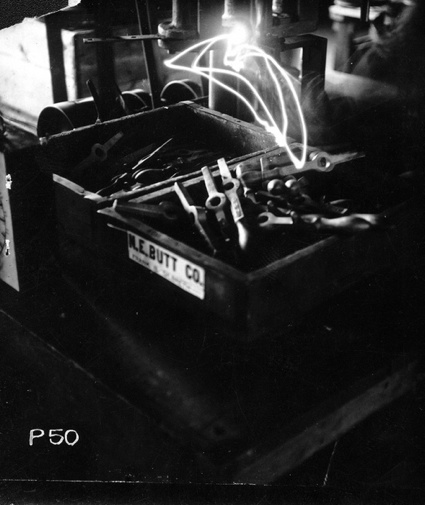 From image verso: “2 cycles on drill press showing ‘HABIT’ positioning after transporting. Note the ‘hesitation’ before ‘grasping.'” Circa 1915. Collection: Frank B. Gilbreth Motion Study Photographs (1913-1917). Repository: The Kheel Center for Labor-Management Documentation and Archives
From image verso: “2 cycles on drill press showing ‘HABIT’ positioning after transporting. Note the ‘hesitation’ before ‘grasping.'” Circa 1915. Collection: Frank B. Gilbreth Motion Study Photographs (1913-1917). Repository: The Kheel Center for Labor-Management Documentation and Archives
More images: Frank B. Gilbreth Motion Study Photographs (1913-1917) at Kheel Center Labor Photos.
